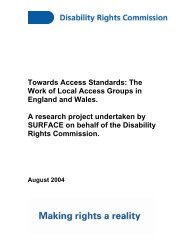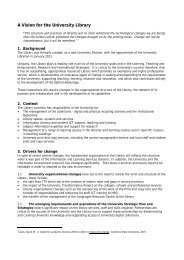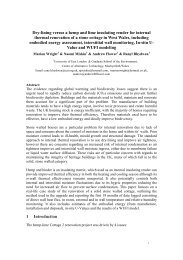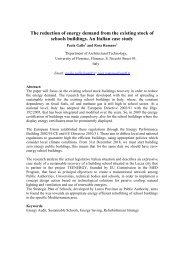Download a copy (pdf) - University of Salford
Download a copy (pdf) - University of Salford
Download a copy (pdf) - University of Salford
You also want an ePaper? Increase the reach of your titles
YUMPU automatically turns print PDFs into web optimized ePapers that Google loves.
Design Against Crimewas established at the<strong>University</strong> <strong>of</strong><strong>Salford</strong> in 1999 via aproject funded by theUK Design Counciland the Home <strong>of</strong>fice,as part <strong>of</strong> a nationalprogramme <strong>of</strong> policy initiatives to embed crimeprevention in design practice and education.In 2003 the Design Against Crime SolutionCentre was established, which is a uniquepartnership with Greater Manchester Policeand the Dutch research and planningconsultancy, DSP-groep. The Solution Centreprovides leadership in design-led andsustainable practice to improve crimeprevention and community safety, and worksin partnership with police forces, governments,planning authorities, the voluntary sector,service users and communities.“The research cluster here at the DesignAgainst Crime Solution Centre <strong>of</strong>fers adistinctive approach, and considers ‘design’as referring not simply to the physical design<strong>of</strong> environments or products, but includesresearch, analysis, evaluation and theformulation <strong>of</strong> integrated systems <strong>of</strong> deliveryand value adopted by stakeholders,” explainsDr Caroline Davey, Co-Director <strong>of</strong> the Centre.“Our approach is very much informed byhuman-centred design and systems design,and we adopt a focus on the constituentsystems <strong>of</strong> meaning, learning, delivery[practice] and value [impact]. The impact <strong>of</strong>our work is underpinned by research that hastaken place in a number <strong>of</strong> key projects.”The youth <strong>of</strong> today…have got lots to sayOne <strong>of</strong> these projects is Youth Design AgainstCrime (YDAC), a programme to engageyoung people in design-led crime prevention,developed by the Design Against CrimeSolution Centre and national young people’scharity, Catch22. Supported by youth workersand teachers, and mentored by local police<strong>of</strong>ficers, the project sees multiple teams <strong>of</strong> upto nine young people challenged to addressissues <strong>of</strong> crime and community safety in theirneighbourhoods, and the ideas generatedare presented to senior local stakeholdersfrom agencies including the police, planningauthorities and local councils. YDAC is novelin its approach because it is aimed at youngpeople who have come to the attention <strong>of</strong>schools or police authorities due to behaviouralproblems, and who may be excluded fromschool and following an alternative curriculum.Dr Caroline Davey and Andrew Wootton, Co-Directors <strong>of</strong>the Design Against Crime Solution CentreUsing these challenges really improvesyoung people’s confidence, knowledge,qualifications and skills, and fosters betterrelationships with the adult participants,including police mentors.“People are starting to realise the value inencouraging young people to participate inprojects that have a direct impact on decisionsabout environments and spaces, including thepublic realm <strong>of</strong> towns and cities,” says AndrewWootton, also Co-Director <strong>of</strong> the SolutionCentre. “YDAC challenges young peopleconsidered ‘at risk <strong>of</strong> <strong>of</strong>fending’ to addressproblems in their neighbourhoods, using aprocess <strong>of</strong> research and design to helpgenerate innovative and evidence-basedsolutions to crime problems. Using thesedesign challenges really improves youngpeople’s confidence, knowledge, qualificationsand skills, and fosters better relationshipswith the adult participants, including policementors. The young people we work withdevelop creative solutions to problems,and are able to convince stakeholders involvedin policing, community safety and urbanplanning <strong>of</strong> the value <strong>of</strong> their ideas.”With YDAC structured to run over ten to12 weeks, young people completing theprogramme and associated workbook have theopportunity to gain an ASDAN Wider Skills Level2 problem-solving qualification, which in turncan be a springboard to further study.During the first three weeks <strong>of</strong> the programmethe participants undertake team-buildingactivities, including identifying individualstrengths and weaknesses, creating a teamname and choosing an area to focus on.The scanning and mapping stage (weeks fourto six) involves researching the focus area,considering why it is important to the teammembers, looking deeper into the issues andunderstanding how they can be addressed.A police mentor assists this process and workswith the teams to research problems in the area,as experienced by other users, and thena ‘problem pr<strong>of</strong>ile’ is produced.During weeks six to ten the groups developdesign concepts in response to their research,which are then evaluated in terms <strong>of</strong> theirpotential impact on users, crime and antisocialbehaviour. A final design concept is thenselected and in weeks ten to 12 the youngpeople develop drawings, models, presentationmaterials and arguments to communicate to thejudging panel at the YDAC showcase evening.At this event each group is given ten minutesto present their finished design to the judgingpanel and an audience <strong>of</strong> friends, family andinvited stakeholders, before taking questions forfive minutes. One group is then selected by thejudging panel as the YDAC winner, and receivesa trophy, while all runners up are awardedmedals and certificates <strong>of</strong> completion.May 2013 | 5

















